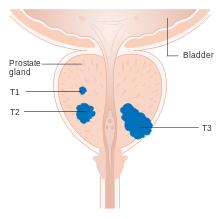Prostate Cancer Treatment. What is Prostate Cancer, Symptoms, and Treatment? Prostate cancer, a prevalent form of cancer among men, is a topic of significant concern and awareness. In this article, we’ll delve into the intricacies of prostate cancer, its symptoms, available treatments, and the importance of early detection.
I. Introduction
Definition of Prostate Cancer
Prostate cancer originates in the prostate, a small gland that produces seminal fluid. When cells in the prostate undergo abnormal growth, it leads to the development of cancerous tumors.
Prevalence and Importance of Awareness
Prostate cancer is the second most common cancer in men globally. Creating awareness about its risks, symptoms, and preventive measures is crucial for early detection and effective treatment.
II. Understanding Prostate Cancer
Risk Factors
Certain factors, including age, family history, and race, contribute to the risk of developing prostate cancer. Understanding these risk factors is essential for proactive health management.
Common Symptoms
Early symptoms of prostate cancer may include changes in urinary habits, erectile dysfunction, and discomfort in the pelvic region. Recognizing these signs can prompt timely medical intervention.
Diagnosis and Early Detection
Regular prostate-specific antigen (PSA) tests and digital rectal exams (DRE) are vital for early detection. These screenings enable physicians to identify potential issues before symptoms become pronounced.
III. Types and Stages of Prostate Cancer
Differentiating Types
Prostate cancer exists in various forms, including adenocarcinoma, sarcoma, and small cell carcinoma. Understanding these distinctions guides treatment decisions.
Staging Process
The staging of prostate cancer involves determining the extent of its spread. Stages range from I to IV, with higher stages indicating more advanced cancer.
IV. Treatment Options
Surgery
Surgical procedures like radical prostatectomy aim to remove the cancerous prostate. Understanding the potential side effects and benefits is crucial when considering surgery.
Radiation Therapy
Radiation therapy utilizes high-energy rays to target and eliminate cancer cells. It is a common treatment option that can be employed independently or in conjunction with other therapies.
Hormone Therapy
Hormone therapy involves reducing the levels of male hormones to inhibit cancer growth. It is often recommended for advanced cases.
Watchful Waiting
In certain cases, especially for older patients or those with slow-growing tumors, a watchful waiting approach may be adopted to monitor the cancer without immediate intervention.
V. Lifestyle and Prevention
Diet and Exercise
Maintaining a healthy lifestyle, including a balanced diet and regular exercise, is associated with a reduced risk of prostate cancer. Incorporating these habits can contribute to overall well-being.
Regular Health Checkups
Regular checkups and screenings are essential for early detection. Consultation with healthcare professionals ensures timely intervention if any abnormalities are detected.
VI. Coping with Prostate Cancer
Emotional Impact
A prostate cancer diagnosis can have a significant emotional impact. Building a strong support system and seeking emotional assistance are crucial aspects of coping with the challenges that arise.
Support Systems
Engaging with support groups and involving family members in the treatment journey provides invaluable emotional and practical support.
VII. Advances in Prostate Cancer Research
Immunotherapy
Ongoing research explores immunotherapy as a potential breakthrough in treating prostate cancer. Enhancing the body’s immune response can target and eliminate cancer cells effectively.
Targeted Therapies
Advances in targeted therapies aim to address specific characteristics of cancer cells, minimizing damage to healthy cells. These therapies show promise in improving treatment outcomes.
VIII. Frequently Asked Questions
How common is prostate cancer?
Prostate cancer is the second most common cancer in men globally, with a significant impact on the male population.
What are the early signs of prostate cancer?
Early signs may include changes in urinary habits, erectile dysfunction, and pelvic discomfort. Seeking medical advice for these symptoms is crucial.
Are there alternative treatments available?
While conventional treatments like surgery and radiation therapy are common, some individuals explore alternative therapies. It’s essential to discuss these options with healthcare professionals.
How can one reduce the risk of prostate cancer?
Adopting a healthy lifestyle, including a balanced diet and regular exercise, can contribute to reducing the risk of prostate cancer.
What is the latest in prostate cancer research?
Current research focuses on immunotherapy and targeted therapies, offering potential breakthroughs in treating prostate cancer.
In conclusion, understanding prostate cancer, its symptoms, and available treatments is crucial for proactive health management. Regular screenings, adopting a healthy lifestyle, and staying informed about advances in research contribute to better outcomes. For those facing a prostate cancer diagnosis, building a robust support system is essential for emotional well-being and navigating the treatment journey.

